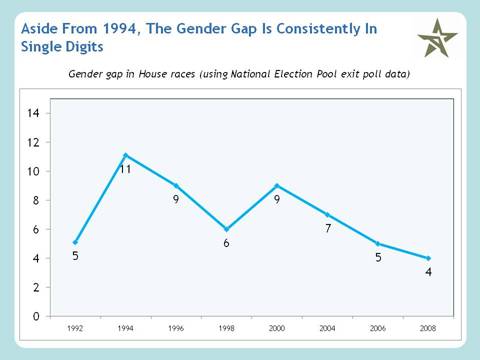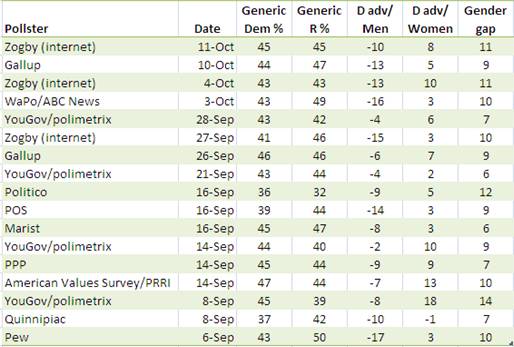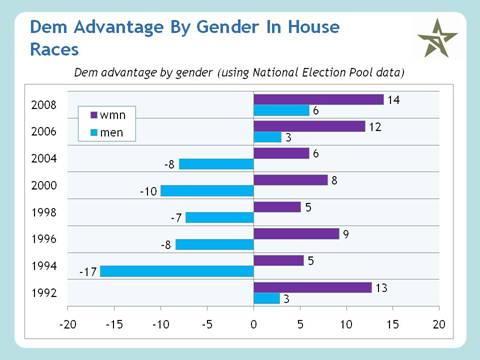
As I wrote recently, many are wondering whether women can prevent changeovers in the House and Senate this November. But how much ground do women need to make up? And has this ever happened in the past?
There will be a gender gap.
Make no mistake, more women will vote Democratic this November. That's been true in presidential elections since 1980, and it has been true nationally in House races in the last eight cycles examined (using National Election Pool exit poll data; no data for 2002). And in 17 public sets of crosstabs since early September, there's a gender gap in the generic Congressional ballot in every single one. (Gender gap here is defined as the difference between men and women in the vote for the majority party.)

The gap may grow this year.
Over the past eight elections, the average gap was 7 points. And in every year but one, the gap was in single digits. But in the crosstabs from the recent public polls, the gender gap is frequently in double digits. And averaging them, the gap is 9 points. So the gender gap this year seems likely to grow. (In the table below, Zogby and Gallup crosstabs were provided directly from the pollsters. Given the average of the generic across these 17 surveys is a 1-point Republican advantage, the gender gap is based off of the difference in Republican support. If you have additional recent data send it my way and I'll update.)

But Democrats might need a gap that's even wider.
Examining the Democratic advantage by gender in past exit polls reveals two consistent rules of using gender to predict which party wins the House majority. First, men predict the winner of the majority. When men give Democrats the edge in exit polls, Democrats win the majority of House seats. When men don't, Democrats don't. Second, when women give Democrats a double-digit margin in exit polls, Democrats win the majority of House seats. When women don't, Democrats don't.

But looking back to the table of current polling, only occasionally do women give Democrats a double-digit margin. And men consistently give Republicans the advantage. Now while nothing is decided until election day, this current combination is a major warning sign for Democrats.
So my urgent advice to my fellow Democrats:
- Reach out to non-Democratic women who are frequently receptive to our messaging.
- Some women-centric messaging crosses party lines, like maternity care, sexual harassment, and equal pay.
- To turn out the base, highlight what's at stake for women.
- Leave the process arguments for cable news and blogs.
- Make sure your internal polling explores gender differences, party by gender interactions, and messaging tailored specifically to women (but asked of both genders).
- "Women's issues" is not interchangeable with "abortion." (Although it can be important in some races.)
- Continue to use women validators, like Michelle Obama.
- For candidates getting hit on health care anyway, don't be afraid to talk about reform's impact on women. In particular, breast cancer coverage and care for newborn children.
- Integrate women-oriented media outlets to get across compelling stories about women candidates and political issues.